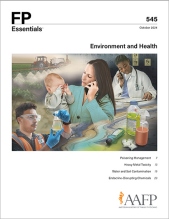
These key learning points summarize the consensus- and evidence-based recommendations included in this edition. The sources listed here for each statement recommend that physicians perform or implement these actions directly in a clinical setting.
1. For evaluation of patients with suspected arsenic toxicity, perform a complete history and physical examination with laboratory tests and imaging as appropriate. These may include a complete blood cell count with peripheral smear, blood urea nitrogen (BUN) and creatinine levels, liver function tests, nerve conduction studies, electrocardiogram, and abdominal and chest X-rays.
Evidence rating: SORT C
Source: Agency for Toxic Substances and Disease Registry (ATSDR), reference 29
Website: https://www.atsdr.cdc.gov/csem/arsenic/cover-page.html
2. For evaluation of patients with suspected chronic cadmium toxicity, perform a complete history, physical examination, and laboratory tests. BUN, cadmium, creatinine, electrolyte, and urinary protein levels should be obtained.
Evidence rating: SORT C
Source: ATSDR, reference 32
Website: https://www.atsdr.cdc.gov/csem/cadmium/cover-page.html
3. For children at risk of lead exposure, perform blood lead level screening with a capillary or venous blood test. Children more likely to be exposed include those who live or spend time in a building built before 1978; are from low-income households; are immigrants, refugees, or recently adopted from low-resource countries; live or spend time with an individual who works with lead; and live or spend time with an individual that has hobbies that expose them to lead.
Evidence rating: SORT C
Source: Centers for Disease Control and Prevention (CDC), reference 44
Website: https://www.cdc.gov/lead-prevention/testing/index.html
Subscribe
From $350- Immediate, unlimited access to FP Essentials content
- 60 CME credits/year
- AAFP app access
- Print delivery available
Edition Access
$44- Immediate, unlimited access to this edition's content
- 5 CME credits
- AAFP app access
- Print delivery available
